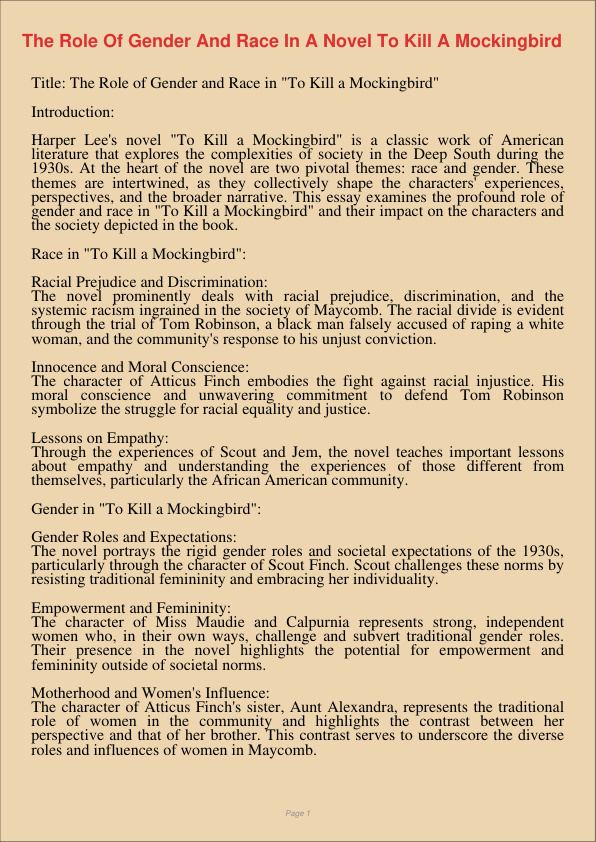The Role Of Gender And Race In A Novel To Kill A Mockingbird
Jan 9, 2024
role
race
Social science
Family & Consumer Science

Title: The Role of Gender and Race in “To Kill a Mockingbird”
Introduction:
Harper Lee’s novel “To Kill a Mockingbird” is a classic work of American literature that explores the complexities of society in the Deep South during the 1930s. At the heart of the novel are two pivotal themes: race and gender. These themes are intertwined, as they collectively shape the characters’ experiences, perspectives, and the broader narrative. This essay examines the profound role of gender and race in “To Kill a Mockingbird” and their impact on the characters and the society depicted in the book.
Race in “To Kill a Mockingbird”:
Racial Prejudice and Discrimination: The novel prominently deals with racial prejudice, discrimination, and the systemic racism ingrained in the society of Maycomb. The racial divide is evident through the trial of Tom Robinson, a black man falsely accused of raping a white woman, and the community’s response to his unjust conviction.
Innocence and Moral Conscience: The character of Atticus Finch embodies the fight against racial injustice. His moral conscience and unwavering commitment to defend Tom Robinson symbolize the struggle for racial equality and justice.
Lessons on Empathy: Through the experiences of Scout and Jem, the novel teaches important lessons about empathy and understanding the experiences of those different from themselves, particularly the African American community.
Gender in “To Kill a Mockingbird”:
Gender Roles and Expectations: The novel portrays the rigid gender roles and societal expectations of the 1930s, particularly through the character of Scout Finch. Scout challenges these norms by resisting traditional femininity and embracing her individuality.
Empowerment and Femininity: The character of Miss Maudie and Calpurnia represents strong, independent women who, in their own ways, challenge and subvert traditional gender roles. Their presence in the novel highlights the potential for empowerment and femininity outside of societal norms.
Motherhood and Women’s Influence: The character of Atticus Finch’s sister, Aunt Alexandra, represents the traditional role of women in the community and highlights the contrast between her perspective and that of her brother. This contrast serves to underscore the diverse roles and influences of women in Maycomb.
Intersection of Gender and Race:
Black Women’s Experiences: The novel subtly depicts the unique struggles and experiences of black women, as seen through the character of Calpurnia. She occupies a complex position, working for the Finch family while also being a mother figure to Scout and Jem.
Mayella Ewell’s Tragic Situation: The character of Mayella Ewell exemplifies the intersection of race and gender, as her abuse by her father, Bob Ewell, reflects the broader racial dynamics of Maycomb. She is both a victim of her circumstances and a perpetuator of racial injustice due to her false accusations against Tom Robinson.
Conclusion:
“To Kill a Mockingbird” masterfully weaves the themes of race and gender to illustrate the complex and interconnected nature of social issues. The novel portrays the challenges faced by both African Americans and women in a society marked by deep-seated prejudices and expectations. By exploring the experiences of characters like Tom Robinson, Scout Finch, Calpurnia, and Mayella Ewell, the novel invites readers to reflect on the ongoing struggle for equality, justice, and individual agency in the face of societal norms and prejudice.